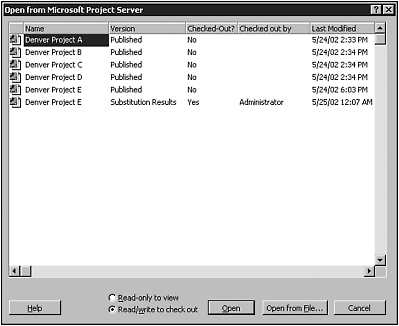Working with Versions
Full comparisons between versions, including added and deleted tasks and assignments, constraints, and other changes not saved in baselines.
Trend analysis between schedule snapshots taken at regular intervals.
What-if analysis separate from the current (or published) version.
There is no limit to the number of versions that an organization can create; however, only versions that have been predefined by the administrator are available to project managers.
The first time a new project schedule is saved to a Project server, it must be saved with the system version called Published. This is because the Published version is associated with system features such as timesheet reporting (timesheets only show assignments from the Published version).
NOTE
Because of its importance and the necessity for it to exist, the version Published is protected and cannot be deleted.
After the Published version of a project is saved, other versions of the project can be saved also. For example, if you have predefined a Test version and a What If version, then only those versions are available for use through Microsoft Project and Project Web Access. If the organization decides that a copy of each schedule in the organization should be saved at the end of each quarter, you can create Q1 2002, Q2 2002, Q3 2002, Q4 2002, and other versions, as necessary.
TIP
Your organization might want to define several types of version definitions that reflect business processes. The Published version is the default production version when you save a project plan into the enterprise repository. You can also create versions such as Suspended, Preliminary, Pending Approval, and so on, as defined by the project approval and tracking processes established by your business.
You can view project versions in the Professional edition’s Open File dialog box or at Project Web Access Project. When viewing projects at Project Web Access, you can sort, group, and filter by version.
Opening Schedules Using Versions
To display a list of all open projects that you have permission to view and their versions, select File, Open while in Microsoft Project Professional and connected to the Project server. The dialog box shown in Figure 26.15 appears.
Figure 26.15. Each project schedule stored on a Project server must be associated with at least the Published version.

Saving Schedules Using Versions
Specifying versions of a project allows you to maintain a Published version while independently updating other versions. When you save a project for the first time, or if you select File, Save As, you are prompted for the project name and version, as shown in Figure 26.16.
Figure 26.16. You can save the Denver E project as the What If version.

Versions and the Resource Pool
Unlike the Project Server, which can hold many versions of the same project schedule, the enterprise resource pool holds only one version of resources and their availability, calendars, outline codes, and so on.
Assignments of resources to tasks in projects, however, reflect the version of the project to which they belong at the time the version was created. The complete resource usage picture is contained with the global resource pool, so managers in an organization can see the workload on individual resources. This also enables project managers to dynamically inspect the workload when the Team Builder is used to assemble a team for a project.
Versions and Cross-Project Links
When you use cross-project links, you need to be careful with your use of versions. Cross-project links must be maintained between projects saved with the same version name. If they are not, the cross-project links exist as static, or orphaned, links that do not automatically update when linked project plans are revised and saved.
For example, if you have a cross-project link between ProjectA.mpp and ProjectB.mpp and then you save both project schedules to a Project server, both projects need to have the same version name in order for the cross-project link to remain active.
If links are orphaned, a dialog box that allows the user to browse for and resolve broken links appears. When you resolve a link, any other links to the same project is resolved as well.

